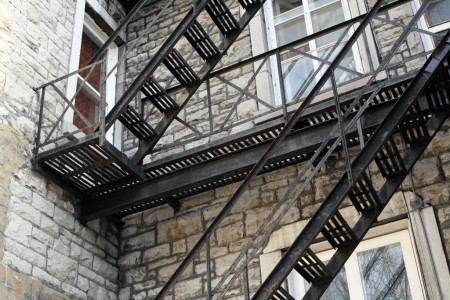The other day, I was crossing the street in the middle of the block, listening to a small voice of conscience chiding me for the ‘dangerous’ act. Then I realized that I had actually chosen to walk partway up the block, rather than using the crosswalk, and that my primary reason for doing so was my own safety.
Intersections try to combine two purposes that mesh poorly: allowing pedestrians to cross roads and allowing drivers and cyclists to make turns. It is obvious that these two goals conflict. People crossing the street don’t want vehicles passing through their area of travel – especially vehicles that move in unexpected directions and at unpredictable speeds. Cars making left-hand and right-hand turns tend to do both.
Perhaps it makes sense to divide these two purposes, then. Put stoplights in the middle of blocks and let pedestrians cross there, leaving intersections exclusively for turning. It might slow down the flow of traffic a bit, but I am actually in favour of moves to make driving less convenient in cities. It would make life safer for pedestrians, by making the crosswalk unambiguously their space when the light is in their favour, and the slowdowns caused by the potential lights would be partially made up for by freeing drivers from having to worry about pedestrians when making turns.
Sure, it would be better to reserve city centres entirely for people on foot, bicycles, and public transit vehicles. This plan is less radical, won’t generate the same outrage from big box stores, and may well save some lives.


This seems like a good idea to me. I will link it to my planning friends.
One concern is that the extra signals might make roads exceptionally cluttered, but I am not sure how problematic that would really be.
In Toronto this is already done in some places – a crosswalk is placed between intersections, and there are yellow flashing lights above it which can be triggered by buttons on either side. This is also often done at intersections in place of a light. Cars nor not obliged to stop – just to stop if pedestrians are crossing. It works very well, I think it impedes the flow of traffic less than conventional lights (also, no one “runs” the yellow as some would run reds).
You also see many crosswalks in the middle of the block near schools. This suggests to me that planners are aware of how they are safer for pedestrians.
Mid-block crosswalks might also be unpopular insofar as they reduce how much curbside space there is for parking.
Cars nor not obliged to stop – just to stop if pedestrians are crossing. My experience is that this works pretty well if there are prominent flashing lights, but without flashing lights (i.e. a zebra crossing) most cars don’t stop if a pedestrian is clearly waiting to cross, & often don’t stop even if the crossing is occupied. Some of the zebra crossings in Vancouver are a lot more dangerous for pedestrians than no crossing at all, because they give you a false sense of security and then cars drive right through them.
This entry identifies the difficulties surrounding interaction between pedestrians and motorists.
During the olympics, Vancouver has closed a number of its downtown streets to cars. I have noticed an increase in positive human interaction. This supports the view that less cars on the road creates more human interaction.
The last comment was mine as I had mistakenly not changed Alena’s name and we share her computer.